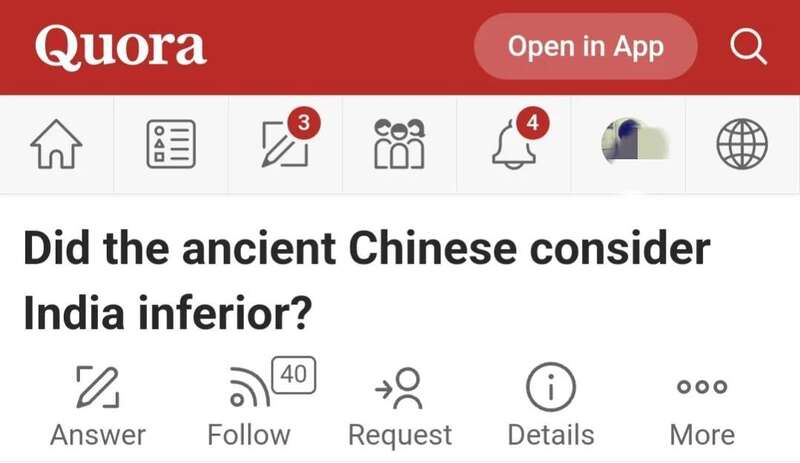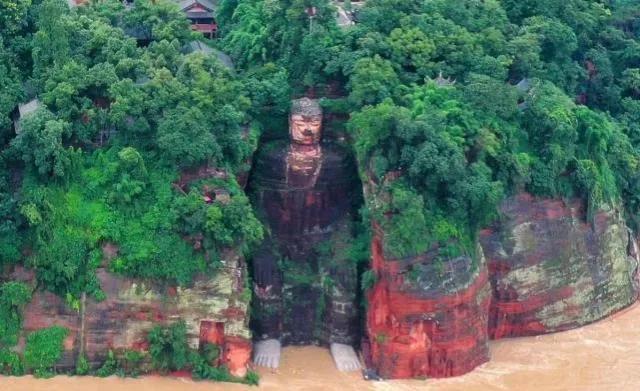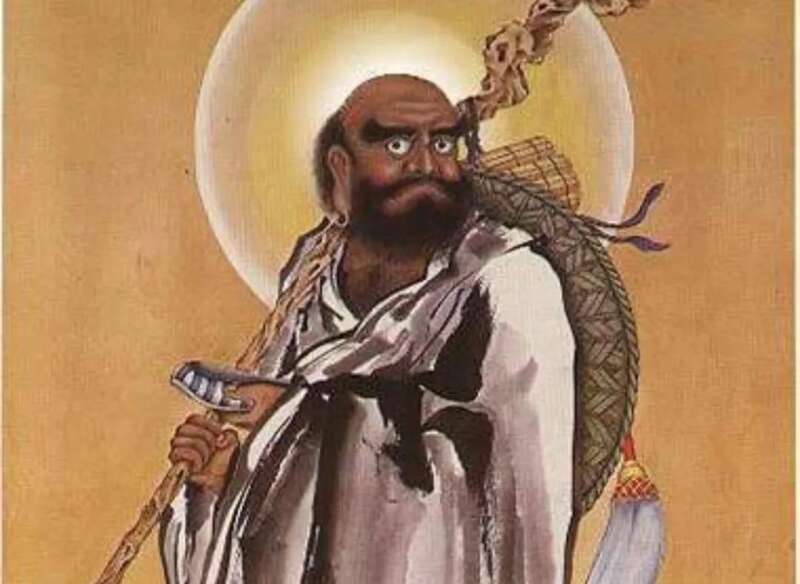
问题

People tend to think that ancient China was an isolationist country, bound by geographical obstacles such as the prairie in the north and the Pacific Ocean in the east. But although this was true in the Ming and Qing Dynasties, it was not always the case in China.
人们倾向于认为古代中国是一个孤立主义国家,被北方的大草原和东部的太平洋等地理障碍所束缚,但尽管在明清时期这是事实,但中国并不总是这样。
Only when China has its own problems to deal with, will China shrink back. Isolation breeds ignorance, ignorance breeds arrogance. Therefore, the paradox is that when the Chinese dynasty was the weakest, it had the highest degree of contempt for other cultures (whether Indians or not), as did other civilizations.
只有当中国有自己的问题需要处理时,中国才会退缩。孤立滋生无知,无知带来傲慢。因此,矛盾的是,当中国王朝最弱的时候,它对其他文化(不管是不是印度人)的蔑视程度最高,其他文明也是如此。
But it would be wrong to say that the Chinese believed that Indians were at a disadvantage in all dynasties. Take the Tang Dynasty as an example. It is the most energetic and confident dynasty among all dynasties. If Tang people think that Indians are inferior, they will not carve an Indian on the cliff.
但如果说中国人认为印度人在各个王朝时期都处于劣势,那就错了。以唐代为例,它是所有王朝中最具活力和自信的一个王朝。如果唐人认为印度人劣等,他们就不会在悬崖上刻出一个印度人。

(乐山大佛)
If Indians are considered inferior. People may not be so keen to talk about how Dharma came to China and his famous audience with Emperor Liang, How did this legendary figure establish Zen Buddhism in China and become the first Zen master in East Asia. And how he helped the development of Shaolin Temple in China. In fact, Bodhidharma has been deeply integrated into the Chinese cultural consciousness. He is one of the most popular statues after Buddha.
如果印度人被认为低人一等。人们可能不会那么热衷于讲述达摩是如何来到中国的,以及他与梁帝的著名听众。这位传奇人物是如何在中国创立禅宗并成为东亚第一位禅师的。以及他如何帮助中国少林寺的发展。事实上,菩提达摩已经深深地融入了中国的文化意识,他是佛陀之后最受欢迎的造像人物之一。

(少林寺达摩像)
But India's prestige does not come entirely from religion. However, this is certainly a large part of it. Through the spread of Buddhism, Indian symbols and patterns are linked with good luck and protection. Look at this blue and white porcelain of the Ming Dynasty. At that time, China claimed to have the strongest fleet in the world.
但印度的声望并不全来自宗教。然而,这当然是其中很大一部分。通过佛教的传播,印度的象征和图案与好运和保护联系在一起。看看这件明代的青花瓷器,当时中国号称拥有世界上最强的舰队。
India's influence is very obvious. Now look at this imperial helmet in the early Qing Dynasty (back view). This is another powerful period in China.
印度的影响非常明显。现在看看这件清代早期的皇盔(后视图),这是中国另一个强大的时期。
同样,梵语的使用几乎可以和好运符划等号。
We all know that China is a country obsessed with jade. In the Qing Dynasty, there was a kind of jade ware famous for its exquisite color and extremely thin shell. Jade is a luxury in China, but this style was especially favored by the Qing court. Its Chinese name is Hindustan Jade English translation: Hindustan Jade.
我们都知道中国是一个痴迷于玉的国家。在清代,有一种玉器以其精致的颜色和极薄的外壳而闻名。翡翠在中国是一种奢侈品,但这种风格尤其受到清廷的青睐。它的中文名字是印度斯坦玉. 英文翻译:Hindustan Jade。

Obviously, any civilization thinks that it is superior to others, but it is unnecessary for them to have any negative views on India at that time. Let me explain:
很明显,任何文明都认为自己比别人优越,但当时他们没有必要对印度有任何负面看法,让我解释一下:
The Chinese have always been proud of their own civilization, and they despise the outside world. They called the tribes living in the north "Huns", the tribes living in the northwest "barbarians", and the Japanese "Dwarf Pirates". But they have different attitudes towards India. They have given India many names, none of which are contemptuous. She is called Xintu, the kingdom of Hindus, or the land of the West. For Buddhists, she is the country of Buddhism.
中国人一向以自己的文明为荣,他们蔑视外界。他们把生活在北方的部落称为“匈奴人”,把生活在西北部的部落称之为“野蛮人”,而日本人则被称为“矮人海盗”。但他们对印度的态度不同。他们给印度起了很多名字,没有一个是轻蔑的。她被称为新图,印度教徒的王国,或提喻,西方的土地,对佛教徒来说,她是佛国。
Many historians have talked about an early ready-made culture coming to China, and they are right. This is the Vedic Hindu culture from India, its Sanskrit and sacred characters, the Chinese contemporary astronomy expertise, and the solar eclipse records are proof; The Chinese philosophy and their way of governing the country all point to the origin of the Vedas. This is why from the earliest days we found that Chinese tourists often visit India to renew their educational and spiritual ties. The introduction of Buddhism into China is one of the most important events in Chinese history.
许多历史学家谈到过一种早期的现成文化来到中国,他们是对的,这是来自印度的吠陀-印度教文化,其梵语和神圣的文字,中国人的当代天文学专业知识,日食记录就是明证;中国人的哲学,他们的治国之道,都指向吠陀起源。这就是为什么从最早的时候我们就发现中国游客经常访问印度,以更新他们的教育和精神联系。佛教传入中国是中国历史上最重要的事件之一。
In 2012, Chinese state-owned media mentioned the greatness of ancient India in the following sentences:
2012年,中国国营媒体在以下几句话中提到了古印度的伟大:
Both Chinese and Indian civilizations originated in the Himalayas and the Tibetan Plateau. In their thousands of years of historical change, there was no conflict. Sages brought ancient Indian culture to China. After the Han Dynasty (206-220 BC), the Three Kingdoms contended for supremacy, and Buddhism made great contributions to the reunification of China. Nowadays, if Indians want to know their own culture and history, they must come to China to obtain historical documents.
中国和印度的文明都起源于喜马拉雅山和西藏高原。在他们持续数千年的历史变革中,没有发生冲突。圣人把印度的古代文化带到了中国。汉朝(公元前206年-220年)之后,三国争雄,佛教对中国的统一作出了巨大贡献。如今,印度人如果想了解自己的文化历史,就必须来中国获取历史文件。

Before the 7th century, Chinese people worshipped Indian culture even more. They sent Faxian and Xuanzang to India to study Buddhist scriptures and brought back many scriptures. Later, the Chinese believed that all Buddhism was introduced into China and localized, but Buddhism disappeared and declined in India, and China became the center of Buddhist culture, higher than India.
在7世纪以前,中国人更崇拜印度文化。他们派法显和玄奘去印度学习佛经,带回了许多经书。后来,中国人认为所有佛教都传入中国并本土化,但佛教在印度消失和衰落,中国成为佛教文化的中心,高于印度。
India, located in the South Asian subcontinent, is one of the four ancient civilizations in the world. For a long time, people often think that India is a small country, far inferior to China. It can't be compared with it now, nor with China in ancient times. In ancient times, India was just a soy sauce character with no sense of existence. In fact, ancient India is not weak, not inferior to the world superpower China, but a world power at the same level as China.
印度位于南亚次大陆,是世界四大文明古国之一。长期以来,人们常常认为印度是一个小国,远不如中国。现在无法与之相比,在古代也无法与中国相比。在古代,印度只是一个没有存在感的酱油角色。事实上,古印度并不弱,不输于世界超级大国中国,是与中国处于同一水平的世界强国。
From the time of civilization origin, ancient Indian civilization was earlier than China. Of course, the ancient Indian civilization was annihilated after being invaded by the Aryans. Compared with the ancient Chinese civilization, it is far from comparable. However, the new Indian civilization dominated by Aryan people is also very developed. Otherwise, India will not become an oriental country with "gold everywhere" in the eyes of Westerners, nor will it trigger Europeans to seek a new route to India. The names of East India and West India are the result of Westerners seeking new routes to India. Westerners' true understanding of rich China actually dates back to the Ming Dynasty.
从文明起源的时间来看,古印度文明早于中国。当然,古印度文明在被雅利安人入侵后被湮灭,与历史悠久的中国古代文明相比,它是远远无法比拟的。然而,雅利安人主导的新印度文明也非常发达。否则,印度不会成为西方人眼中“遍地黄金”的东方国家,也不会引发欧洲人寻求通往印度的新路线。东印度和西印度的名字正是西方人寻找通往印度的新路线的结果。西方人对富裕中国的真正理解实际上要追溯到明朝。
From the perspective of territory, ancient India occupied most of the South Asian subcontinent, with a total area of more than 3 million square kilometers. The area of India during the Asoka period once reached 5 million square kilometers. Although the land area of ancient China was often as high as tens of millions of square kilometers in theory, the actual control of the indigenous core area was only more than 3 million, almost equal to India.
从领土角度来看,古印度占据了南亚次大陆的大部分地区,总面积超过300万平方公里,阿育王时期印度的面积一度达到500万平方公里。尽管古代中国的土地面积理论上往往高达数千万平方公里,但土著核心区的实际控制权只有300多万,几乎与印度持平。
India even has more arable land than China. Of course, China belongs to a unified regime, which is much stronger than loose India, but India should not be underestimated. After all, the Maurya Dynasty was once the world's largest power, the Sultanate of Delhi defeated India, and the Mughal Empire was as famous as the Qing Dynasty.
根据可耕地面积,印度甚至比中国多。当然,中国属于一个统一的政权,比松散的印度强大得多,但印度不容小觑。毕竟,毛里亚王朝曾经是世界第一强国,德里苏丹国打败了印度,莫卧儿帝国也与清朝齐名。
In terms of population, ancient China was the most populous country in the world, but India had a large population, sometimes even more than China. During the Maurya Dynasty, India had a population of 26.5 million (about 50 million), more than that of the Qin Dynasty. Of course, most of the time, China has always been the most populous country in the world, but India and China are not very different.
就人口而言,古代中国是世界上人口最多的国家,但印度人口众多,有时甚至超过中国。毛里亚王朝时期,印度人口2650万(约5000万),比当时的秦朝还要多。当然,大多数时候,中国一直是世界上人口最多的国家,但印度和中国没有太大区别。
According to the statistics of the "rough estimate of ancient world population", the proportion of ancient Chinese population in the world has fluctuated between 20-35%, while that of ancient India fluctuated between 18-30%. The ancient population was wealth. As India's agriculture and commerce are also very developed, the wealth created by Indians is not much less than that of China. In ancient times, it was the world's second largest economy after China.
根据“古代世界人口粗略估计”统计,中国古代人口在世界上的比例一直在20-35%之间波动,印度古代人口在18-30%之间波动。古代人口是财富。由于印度的农业和商业也很发达,印度人创造的财富并不比中国少多少。在古代,它是仅次于中国的世界第二大经济体。
From an economic perspective, due to India's special position, ancient India was one of the economic centers of Asia and Europe, and India played an important role in Eurasian trade. India's gold, pepper, gems, spices, cotton cloth and other commodities are very popular in Europe.
从经济角度来看,由于印度的特殊位置,古印度是亚欧经济中心之一,印度在欧亚贸易中发挥了重要作用。印度的黄金、胡椒、宝石、香料、棉布等商品在欧洲很受欢迎。
The most important reason for Westerners to open up new routes is to obtain Indian spices, which prompted many businessmen and adventurers to find new routes to India. Of course, when Westerners found a new route to China, China soon became the most important trading partner of Europeans. During the Ming Dynasty, one third of the world's new silver flowed into China.
西方人开辟新航线的最重要原因是获得印度香料,这促使许多商人和冒险家寻找前往印度的新航线。当然,当西方人发现一条通往中国的新路线时,中国很快就成为了欧洲人最重要的贸易伙伴。明朝时期,世界上三分之一的新白银流入中国。
From a military perspective, China's military strength is obviously stronger than India's. However, since most of India is a regime established by foreign nomads, its power is not weak. Even the Mongols have nothing to do with India. The Mongols attacked India three times and were repelled.
从军事角度来看,中国的军事实力明显强于印度。然而,由于印度大部分地区是由外国游牧民族建立的政权,因此其势力并不弱。甚至蒙古人也与印度无关。蒙古人三次进攻印度,被击退。
From a cultural perspective, Indian culture is also very developed. As India is closer to West Asia, Europe and other places and has closer cultural exchanges with other places, it has created a splendid Indian culture. India is very developed in literature, medicine, religion and technology. Indian culture can influence China and Southeast Asia, which to some extent reflects that Indian culture is also very developed.
从文化的角度来看,印度文化也很发达。由于印度距离西亚、欧洲等地更近,与其他地方的文化交流也更密切,因此创造了灿烂的印度文化。印度在文学、医学、宗教和技术方面非常发达。印度文化可以影响中国和东南亚,在一定程度上反映了印度文化也很发达。
In general, ancient India was slightly inferior to China, but as a world power once as famous as China, India should not be underestimated. In ancient times, we should not be underestimated, and now people should not underestimate India.
总体而言,古印度略逊于中国,但作为曾经与中国齐名的世界大国,印度不容小觑。在古代,我们不应该被低估,现在人们也不应该低估印度。

No, I don't think they did - ancient China really had a very, very positive impression of the ancient Indian civilization, perhaps the only "barbaric" civilization comparable to their own "Middle Kingdom". The Chinese regard Indians as teachers of wisdom and knowledge, and Buddhism is the only foreign religion that the rulers of the Chinese empire converted to. When the relationship between China and India was destroyed, they lost a friend, while Indians lost almost nothing.
不,我认为他们没有——古中国对印度古代的文明确实有非常非常积极的印象,也许是唯一的可以与他们自己的“中王国”相媲美的“野蛮”文明。中国人把印度人视为智慧和学问的老师,佛教是中国帝国统治者皈依的唯一外国宗教。当中国与印度的关系被破坏时,他们失去了一个朋友,而印度人几乎什么都没有失去。
But that's not all. The Chinese also regarded the British colony of India as a negative example and believed that its ancient culture - the culture of the Indus River and the Buddhist kingdom - had long since disappeared.
但这并不是全部。中国人还将英国殖民地的印度视为一个负面的例子,并相信其古老文化——印度河和佛教王国的文化——早已消逝。
Hu Shih did say that India conquered China for 2000 years without sending a soldier. He meant that Buddhism weakened China from within, but I don't think they must be correct.
胡适(Hu Shih)确实表示,印度征服了中国两千年,没有派遣一名士兵,他的意思是,佛教从内部削弱了中国,但我不认为它们一定正确。
If they really understand the lessons of India, they will know exactly how and why China has stagnated in modern times. Even under the leadership of the current government, India has demonstrated extraordinary adaptability - but strong GDP growth alone cannot hide the fact that society is seriously unbalanced.
如果他们真的了解印度的教训,他们就会确切地了解中国近代如何以及为什么会停滞不前。即使在现任政府的领导下,印度也表现出了非凡的适应能力——但仅凭强劲的GDP增长无法掩盖社会严重失衡的事实。
The Chinese can "adapt". In some aspects, Indians are not easy to do, and Indians are not so... balanced. Many of them still understand and remember the really important things. Although they are willing to die for the really important things, they are not willing to sacrifice themselves for progress or equality. They understand that the real purpose does not always justify the means.
中国人可以“适应”“在某些方面,印度人不容易做到,印度人不那么……平衡。他们中的许多人仍然理解并记住真正重要的事情,尽管他们愿意为真正重要的事而死,但他们不太愿意为了进步或平等而牺牲自己。他们明白,真正的目的并不总是证明手段的正当性。
Look at their two national anthems - one is a profound account of building a new "Great Wall" with millions of people's blood, and the other is a poem of victory written by Tagore, praising Barat himself, describing the rich structure of Punjab, Sindh, Gujarat, Malat, Dravid, Orizan and Bangladesh, as well as Hindus, Buddhists, Jainists, Sikhs and Pasis, Muslims and Christians together constitute a unique identity of a whole civilization, not through the struggle of violent revolution, but through the choice of non violence and non cooperation.
看看他们的两首国歌——一首是深刻讲述用数百万人的鲜血筑起一道新的“长城”,另一首是泰戈尔写的胜利之诗,赞美巴拉特本人,描述了旁遮普、信德、古吉拉特、马拉特、德拉维、奥里桑和孟加拉的丰富结构,以及印度教徒、佛教徒、耆那教徒、锡克教徒、帕西人,穆斯林和基督教徒共同构成了一个整体文明的独特身份,不是通过暴力革命的斗争,而是通过非暴力不合作的选择。

Yes, the Chinese do think we are inferior. But no matter who thinks we are inferior, this is just a misunderstanding. If you study history, you will find that we Indians have the smartest brains from the beginning.
是的,古代中国人确实认为我们低人一等。但无论谁认为我们低人一等,这都只是一种误解。如果你去学习历史,你会发现我们印度人从一开始就拥有最聪明的大脑。
Maharishi Kannada was the first to tell us that if we continue to split matter, we will find the smallest particle called atom.
马哈里希·卡纳达(Maharishi Kannada)是第一个告诉我们,如果我们继续分裂物质,我们会发现被称为原子的最小粒子。
2. Mathematics is incomplete without zero. Aryabhatta, another Indian, found the number 0.
2.数学没有零是不完整的,另一位印度人Aryabhatta发现了数字0。
3. Aryabhatta was the first person to use banana peel to count the number of stars in the Milky Way.
3.Aryabhatta是第一个借助香蕉皮统计银河系恒星数量的人。
4. Many words in English and Chinese are derived from Sanskrit. For example, Sanskrit Mattr and Bhratr developed into English mothers and brothers.
4.英译汉英语中的许多单词都源自梵语。例如:梵语Mattr、Bhratr发展成英语的母亲和兄弟。
So all this is nonsense. We are worse than anyone. The fact is that India is a country that has been plundered many times by many rulers, and it is also one of the most prosperous countries in the world.
所以这一切都是胡说八道,我们比任何人都差。事实是,印度是一个被许多统治者多次掠夺的国家,也是世界上最繁荣的国家之一。

